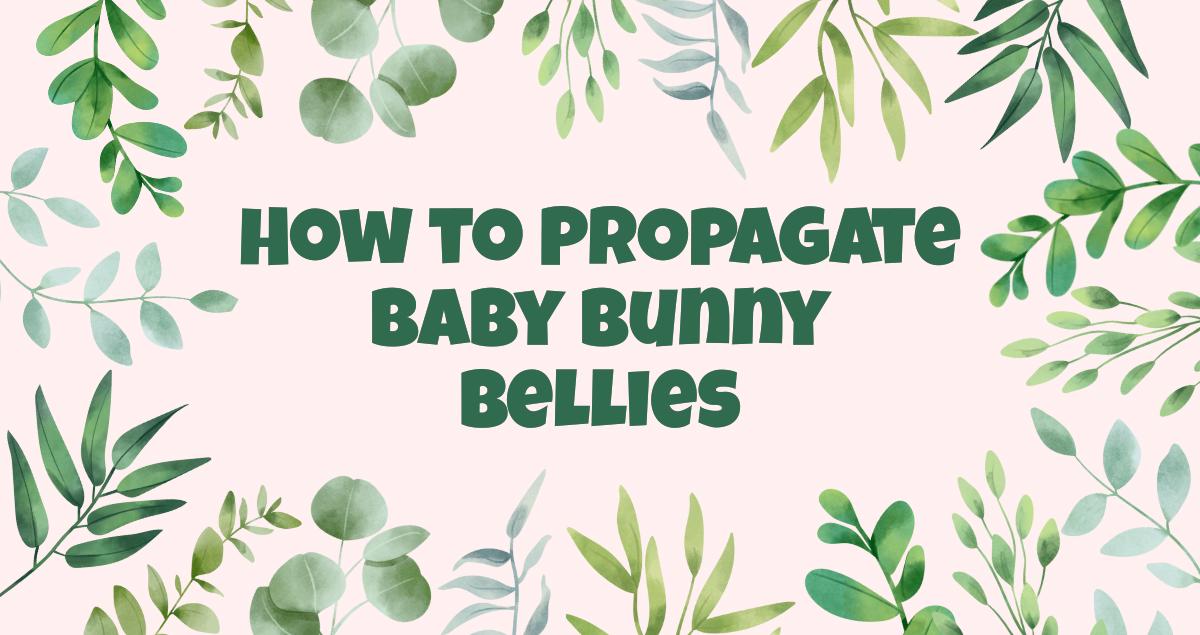Introduction to the process of propagating baby bunny bellies and the benefits of doing so.
Table of Content
How to Propagate Baby Bunny Bellies
To propagate baby bunny bellies, start by selecting a healthy parent plant and gently removing a small offset or pup. Allow the offset to dry for a few days, then plant it in a well-draining soil mix. Place the plant in a bright, indirect light location and water it regularly, ensuring the soil remains moist but not waterlogged. With proper care, the baby bunny belly will grow into a beautiful plant.
Overview of Propagating Baby Bunny Bellies
Baby bunny bellies are a crucial aspect of the propagation process, and understanding their significance is essential for successful breeding. Propagating baby bunny bellies involves carefully selecting parent bunnies, creating a suitable environment, employing appropriate breeding techniques, and providing proper care and nutrition throughout the process. By following these steps, you can ensure the healthy growth and development of baby bunny bellies, leading to adorable and thriving bunnies.
1. Understanding Baby Bunny Bellies
Baby bunny bellies are the adorable plump tummies of young bunnies. They are significant in the propagation process as they indicate the health and well-being of the baby bunnies. A round and firm belly suggests proper nutrition and growth, while a sunken or distended belly may indicate underlying health issues. Monitoring the growth and development of baby bunny bellies is crucial to ensure the overall health and vitality of the bunnies.
2. Selecting the Right Parent Bunnies
Choosing healthy and genetically suitable parent bunnies is vital for successful propagation. Look for parent bunnies that are free from any genetic disorders or diseases. Additionally, consider their temperament and behavior to ensure they are well-suited for breeding. By selecting the right parent bunnies, you increase the chances of producing healthy and robust baby bunny bellies.
3. Preparing the Propagation Environment
Creating a suitable and safe environment is crucial for the growth and well-being of baby bunnies. Provide a spacious and clean enclosure with proper ventilation. Ensure that the temperature and humidity levels are optimal for the bunnies' development. Additionally, provide nesting materials and hiding spots for the pregnant bunnies to feel secure. A comfortable and stress-free environment promotes healthy growth of baby bunny bellies.
4. Breeding Techniques
There are various breeding techniques and methods that can be employed to ensure successful propagation. These include natural mating, artificial insemination, or fostering. Natural mating involves allowing the parent bunnies to mate naturally, while artificial insemination involves manually introducing the male's semen into the female's reproductive tract. Fostering involves transferring the baby bunnies to another nursing mother if the original mother is unable to care for them. Understanding and utilizing the appropriate breeding techniques is essential for the propagation of baby bunny bellies.
5. Caring for Pregnant Bunnies
Pregnant bunnies require special care and nutrition to support the healthy growth of baby bunny bellies. Provide a balanced diet rich in fresh vegetables, hay, and pellets. Ensure they have access to clean water at all times. Regularly monitor their weight and consult a veterinarian for any concerns or complications. Proper care and nutrition during pregnancy contribute to the development of strong and healthy baby bunny bellies.
6. Monitoring the Growth of Baby Bunny Bellies
Regularly checking and monitoring the development and growth of baby bunny bellies is crucial. Observe the size, shape, and firmness of the bellies to ensure they are growing properly. If any abnormalities or concerns arise, consult a veterinarian for guidance. Monitoring the growth of baby bunny bellies allows for early detection of any potential issues and ensures timely intervention.
7. Handling and Socializing Baby Bunnies
Proper handling and socialization of baby bunnies are essential for their well-being and adaptability. Handle them gently and frequently to get them accustomed to human touch. Gradually introduce them to new environments, sounds, and experiences to promote their social skills. This helps them become friendly and well-adjusted bunnies, ready for their future homes.
8. Preventing Common Issues
Identifying and preventing common issues that may arise during the propagation process is crucial for the health of baby bunny bellies. Keep the propagation environment clean and hygienic to prevent infections. Ensure the parent bunnies receive proper nutrition to prevent malnutrition. Regularly monitor the baby bunnies for any signs of illness or distress. By taking preventive measures, you can minimize the risk of common issues and ensure the successful propagation of baby bunny bellies.
9. Weaning and Separation
Gradually weaning the baby bunnies and separating them from their parents is an important step in the propagation process. Introduce solid food gradually while reducing the frequency of nursing. This allows the baby bunnies to transition to a diet suitable for their age. Separation from the parent bunnies should be done gradually, ensuring the baby bunnies are ready to be independent. Providing a safe and comfortable environment during this transition is crucial for their well-being.
10. Finding Suitable Homes for Baby Bunnies
Once the baby bunnies are ready to leave their parents, finding suitable homes for them becomes a priority. Look for responsible and loving individuals or families who are willing to provide a nurturing environment for the bunnies. Screen potential adopters to ensure they understand the responsibilities of bunny ownership and are committed to providing proper care. Finding suitable homes for the propagated baby bunnies ensures their happiness and well-being in the long run.
Conclusion
Properly propagating baby bunny bellies is a rewarding process that requires careful planning, attention to detail, and a commitment to the well-being of the bunnies. By understanding the significance of baby bunny bellies, selecting the right parent bunnies, providing a suitable environment, employing appropriate breeding techniques, and ensuring proper care and nutrition, you can contribute to the growth and development of healthy and happy bunnies. The joy that comes from successfully propagating baby bunny bellies is immeasurable, both for the bunnies and their future owners.
Frequently Asked Questions
Can you propagate Tradescantia in water?
Yes, you can propagate baby bunny bellies (Tradescantia) in water. Simply cut a healthy stem below a node and place it in a container with water. Make sure to change the water every few days to prevent rot and encourage root growth.
How do you take care of a baby bunny belly?
To take care of a baby bunny belly plant, provide it with bright, indirect light and keep the soil consistently moist but not waterlogged. Avoid overwatering as it can lead to root rot. Regularly mist the leaves to increase humidity, and fertilize every month during the growing season with a balanced houseplant fertilizer.
Why is my baby bunny belly plant dying?
There are several reasons why a baby bunny belly plant may be dying. It could be due to overwatering, underwatering, lack of light, or exposure to extreme temperatures. Check the soil moisture, adjust the watering routine, ensure proper light levels, and protect the plant from drafts or direct sunlight to help revive a dying baby bunny belly plant.
Where do you cut Tradescantia for propagation?
When propagating baby bunny bellies (Tradescantia), cut a stem just below a node using clean, sharp scissors or pruning shears. Nodes are the points where leaves attach to the stem. Make sure the cutting has at least one or two nodes to increase the chances of successful propagation.
How often should I water my propagated baby bunny belly plant?
After propagating a baby bunny belly plant, water it thoroughly and then allow the top inch of soil to dry out before watering again. This usually translates to watering every 7-10 days, but always check the soil moisture before watering to avoid overwatering.
Can I propagate baby bunny belly plant in soil directly?
Yes, you can propagate baby bunny bellies directly in soil. Take a stem cutting with a few nodes, remove the lower leaves, and plant it in a well-draining potting mix. Keep the soil lightly moist and provide bright, indirect light to encourage root development and successful propagation.
How long does it take for a baby bunny belly plant to root in water?
Baby bunny belly plants typically root in water within 2-4 weeks. However, the rooting time can vary depending on various factors such as temperature, light levels, and the overall health of the cutting. Patience is key, and once roots have developed, you can transfer the cutting to soil for further growth.

